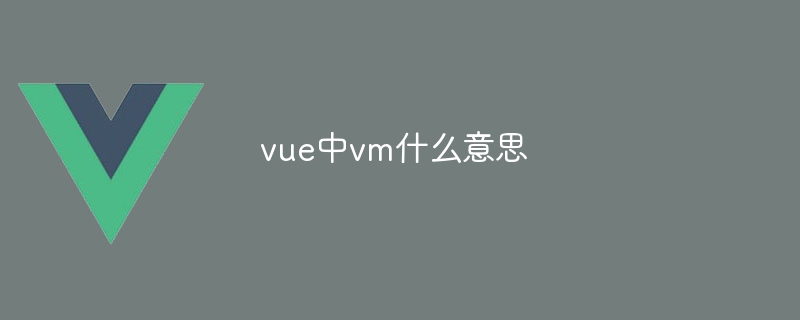What does vm mean in vue
The vm in Vue represents the Vue instance object, which manages the virtual DOM (Virtual DOM), a lightweight representation used to track the actual DOM. Vue instances use vm variables to operate, including accessing data (vm.$data), updating data (vm.$set() and vm.$delete()), accessing methods (vm.$methods) and binding events (vm .$on() and vm.$off()). Understanding what vm means is crucial to working effectively in a Vue application.

The meaning of vm in Vue
In Vue, vm is the opposite of Vue Abbreviation for instance object. It represents an instance of Vue's Virtual DOM, which is a lightweight representation of the actual DOM used by Vue to track and manage.
Vue Instance
Vue instance is the core object in a Vue application. It manages data, templates and logic. To create a new instance in Vue, you can do the following:
const vm = new Vue({
// 选项对象
});vm The variable now references the Vue instance object. It has various methods and properties for accessing and manipulating Vue instances.
Virtual DOM
Virtual DOM is an in-memory lightweight representation used by Vue to track and manage the actual DOM. It stores the state of the DOM, including elements, attributes, and event listeners. Vue detects changes and efficiently updates the real DOM by comparing the virtual DOM with the real DOM.
Usage of vm
#vm Variables can be used to access and manipulate Vue instances. Here are some common uses:
-
Get data:
vm.$dataA data object containing a Vue instance. -
Update data:
vm.$set()andvm.$delete()methods can be used to update data objects. -
Access methods:
vm.$methodsThe object contains the methods of the Vue instance. -
Binding events:
vm.$on()andvm.$off()methods can be used to bind and unbind event.
Conclusion
In Vue, vm is the abbreviation for Vue instance object. It represents an instance of the virtual DOM and provides methods and properties for accessing and manipulating Vue instances. Understanding the meaning of vm is crucial to working effectively in a Vue application.
The above is the detailed content of What does vm mean in vue. For more information, please follow other related articles on the PHP Chinese website!

Hot AI Tools

Undresser.AI Undress
AI-powered app for creating realistic nude photos

AI Clothes Remover
Online AI tool for removing clothes from photos.

Undress AI Tool
Undress images for free

Clothoff.io
AI clothes remover

Video Face Swap
Swap faces in any video effortlessly with our completely free AI face swap tool!

Hot Article

Hot Tools

Notepad++7.3.1
Easy-to-use and free code editor

SublimeText3 Chinese version
Chinese version, very easy to use

Zend Studio 13.0.1
Powerful PHP integrated development environment

Dreamweaver CS6
Visual web development tools

SublimeText3 Mac version
God-level code editing software (SublimeText3)

Hot Topics
 How to use bootstrap in vue
Apr 07, 2025 pm 11:33 PM
How to use bootstrap in vue
Apr 07, 2025 pm 11:33 PM
Using Bootstrap in Vue.js is divided into five steps: Install Bootstrap. Import Bootstrap in main.js. Use the Bootstrap component directly in the template. Optional: Custom style. Optional: Use plug-ins.
 How to add functions to buttons for vue
Apr 08, 2025 am 08:51 AM
How to add functions to buttons for vue
Apr 08, 2025 am 08:51 AM
You can add a function to the Vue button by binding the button in the HTML template to a method. Define the method and write function logic in the Vue instance.
 How to use watch in vue
Apr 07, 2025 pm 11:36 PM
How to use watch in vue
Apr 07, 2025 pm 11:36 PM
The watch option in Vue.js allows developers to listen for changes in specific data. When the data changes, watch triggers a callback function to perform update views or other tasks. Its configuration options include immediate, which specifies whether to execute a callback immediately, and deep, which specifies whether to recursively listen to changes to objects or arrays.
 What does vue multi-page development mean?
Apr 07, 2025 pm 11:57 PM
What does vue multi-page development mean?
Apr 07, 2025 pm 11:57 PM
Vue multi-page development is a way to build applications using the Vue.js framework, where the application is divided into separate pages: Code Maintenance: Splitting the application into multiple pages can make the code easier to manage and maintain. Modularity: Each page can be used as a separate module for easy reuse and replacement. Simple routing: Navigation between pages can be managed through simple routing configuration. SEO Optimization: Each page has its own URL, which helps SEO.
 How to reference js file with vue.js
Apr 07, 2025 pm 11:27 PM
How to reference js file with vue.js
Apr 07, 2025 pm 11:27 PM
There are three ways to refer to JS files in Vue.js: directly specify the path using the <script> tag;; dynamic import using the mounted() lifecycle hook; and importing through the Vuex state management library.
 How to return to previous page by vue
Apr 07, 2025 pm 11:30 PM
How to return to previous page by vue
Apr 07, 2025 pm 11:30 PM
Vue.js has four methods to return to the previous page: $router.go(-1)$router.back() uses <router-link to="/" component window.history.back(), and the method selection depends on the scene.
 How to use vue traversal
Apr 07, 2025 pm 11:48 PM
How to use vue traversal
Apr 07, 2025 pm 11:48 PM
There are three common methods for Vue.js to traverse arrays and objects: the v-for directive is used to traverse each element and render templates; the v-bind directive can be used with v-for to dynamically set attribute values for each element; and the .map method can convert array elements into new arrays.
 How to jump to the div of vue
Apr 08, 2025 am 09:18 AM
How to jump to the div of vue
Apr 08, 2025 am 09:18 AM
There are two ways to jump div elements in Vue: use Vue Router and add router-link component. Add the @click event listener and call this.$router.push() method to jump.






